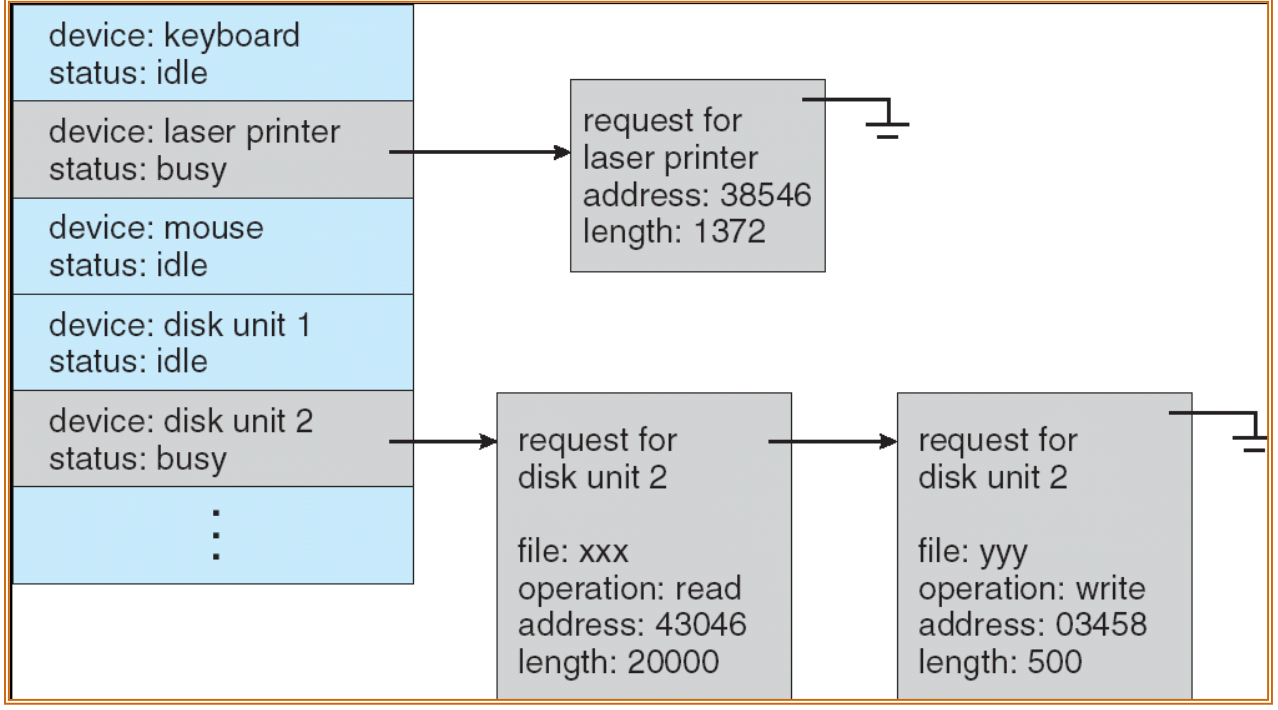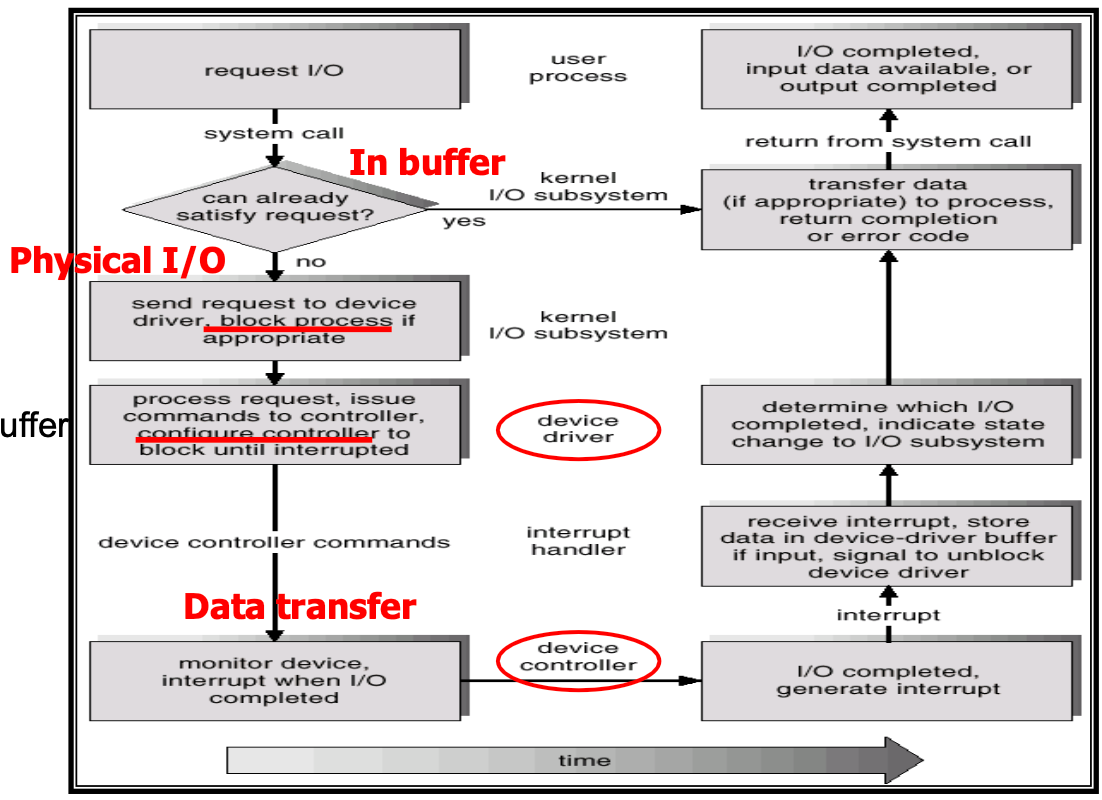[OS] Chapter 13 — I/O System
Overview
電腦不是在做 I/O 就是在做計算
I/O devices: tape, HD, mouse, joystick, network card, screen, flash disks, etc
I/O subsystem: the methods to control all I/O devices
Two conflicting trends
- 我們希望他是 interface,這樣才可以 standardization 的控制
- 但是他又很多樣性
Device drivers: a uniform device-access interface to the I/O subsystem
⇒ Similar to system calls between apps and OS
Device categories
- Storage devices: disks, tapes
- Transmission devices: network cards, modems
- Human-interface devices: keyboard, screen, mouse
- Specialized devices: joystick, touchpad
I/O Hardware
Port: A connection point between I/O devices and the host. 每個 port 都有自己的 ID,那就是 device 對於電腦的 identifier。
→ E.g.: USB ports
Controller: A collection of electronics that can operate a port, a bus, or a device
⇒ A controller could have its own processor, memory, etc. (E.g.: SCSI controller)
Bus: A set of wires and a well-defined protocol that specifies messages sent over the wires(連接的方式,除了物理相接,還有 protocol 的部分)
→ E.g.: PCI bus


I/O Methods
- 透過
port address做什麼事 - Port address 用一個簡單的 table 就好了,反正也沒有很大
- Each I/O port consists of four registers (1~4 Bytes)
- Data-in register — In buffer
- Data-out register — Out buffer
- Status register — 狀態的值
- Control register — command
I/O Methods Categorization
Depending on how to address a device
Port-mapped I/O
- 直接用 I/O instruction (e.g.
IN,OUT)
- 直接用 I/O instruction (e.g.
Memory-mapped I/O
- Access by standard data-transfer instruction (e.g.
MOV)
🙂 More efficient for large memory I/O (e.g. graphic card)
☹️ Vulnerable to accidental modification, error
- Access by standard data-transfer instruction (e.g.
Depending on how to interact with a device:
Poll (busy-waiting): processor periodically check status register of a device. 不停地確認好了沒,啥時可以作下一個
→ 如果量不多,用這個
Interrupt: device notify processor of its completion. I/O 好了他會直接 call interrupt 跟你的程式講。
⇒ 通常會 Memory-mapped I/O + Interrupt 或是另外兩個相加,不然會互相抵銷好處。
Depending on who to control the transfer:
Programmed I/O: transfer controlled by CPU
→ 需要一直用 CPU
Direct memory access (DMA) I/O: controlled by DMA controller (a special purpose controller)
→ 只負責 I/O
- Design for large data transfer
Interrupt
Interrupt Vector Table

Interrupt Prioritization
Maskable interrupt — 有一些不重要的 interrupt 會被 mask 掉
Non-maskable interrupt (NMI): highest-priority, never masked
→ Often used for power-down, memory error
Interrupt-Driven I/O

CPU and device Interrupt handshake
- Device asserts interrupt request (IRQ) → I/O 要註冊他的 interrupt,這樣 OS 才知道要去處理誰
- CPU checks the interrupt request line at the beginning of each instruction cycle
- Save the status and address of interrupted process
- CPU acknowledges the interrupt and search the interrupt vector table for interrupt handler routines
- CPU fetches the next instruction from the handler routine
- Restore interrupted process after executing interrupt handler routine
DMA (Direct Memory Access)

File System → (我要讀多少資料,要讀到 X)→ device driver → (說「我要讀多少資料,要讀到 X」,並 register 一個 interrupt 說「做完之後跟我說欸」) → disk controller → (初始化 DMA,因為他只能傳很少的資料,所以 DMA 就開始不停地送搬移的指令到 disk controller,然後存到 X)→ DMA → (Through interrupt 到 CPU 說我搬完了)→ CPU → 看到搬完了,開心:)
注意那個 X 通常是 physical 的 address,不然就要去看 page table,那就需要 CPU 去跑 OS 來看。
→ 這樣 Virtual Memory 就有點失效,因為那塊就被 fix 住了。
Review Slides ( I )
- Definition of I/O port? Bus? Controller?
- I/O device and CPU communication?
- Port-mapped vs. Memory-mapped
- Poll vs. Interrupt
- Programmed I/O vs. DMA
- Steps to handle an interrupt I/O and DMA request?
Kernel I/O Subsystem
I/O Scheduling
Buffering — Bridge 速差
Caching — Always just a copy; Key to performance
Spooling — 像 buffer,但是是 all or nothing
Error handling — when I/O error happens
I/O protection — Privileged instructions
Device-status Table

Life Cycle of An I/O Request

Performance
- Intercomputer Communications
Application Interface
Textbook Questions


此筆記為清華大學周志遠教授作業系統之課堂筆記,所有內容及圖片皆取材於課堂內容。
如內容有誤,歡迎來信 mail@arui.dev。